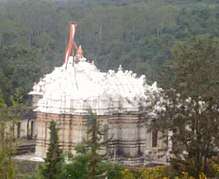Dilwara Temples
| Dilwara Jain Temple | |
|---|---|
 Dilwara Jain Temple | |
 Location within Rajasthan | |
| Basic information | |
| Location | Mount Abu, Sirohi, Rajasthan, India |
| Geographic coordinates | 24°36′33.5″N 72°43′23″E / 24.609306°N 72.72306°ECoordinates: 24°36′33.5″N 72°43′23″E / 24.609306°N 72.72306°E |
| Affiliation | Jainism |
| Festivals | Mahavir Jayanti, Paryushan |
| Governing body | Seth Kalyanji Paramanandji Pedi |
| Architectural description | |
| Creator | Vimal Shah, Vastupal-Tejpal |
| Completed | between the 11th and 13th centuries AD |
| Temple(s) | 5 |
| Part of a series on |
| Jainism |
|---|
 |
|
Jain prayers |
|
Ethics |
|
Major sects |
|
Festivals |
|
|
The Dilwara Temples (Gujarati: અાબુના દેલવાડા) of India are located about 2½ kilometres from Mount Abu, Rajasthan's only hill station. These Jain temples were built by Vimal Shah and designed by Vastupal-Tejpal, Jain laymen[1], between the 11th and 13th centuries AD and are famous for their use of marble and intricate marble carvings. The five marble temples of Dilwara are a sacred pilgrimage place of the Jains. Some consider them to be one of the most beautiful Jain pilgrimage sites in the world.[2] The temples have an opulent entranceway, the simplicity in architecture reflecting Jain values like honesty and frugality. The temples are in the midst of a range of forested hills. A high wall shrouds the temple complex.
Although Jains built some beautiful temples at other places in Rajasthan, Dilwara temples are believed to be the most beautiful example of architectural perfection.[3] The ornamental detail spreading over the minutely carved ceilings, doorways, pillars and panels is simply marvellous.[4]
Five Temples
There are five temples in all, each with its own unique identity. Each is named after the small village in which it is located. These are:
- Vimal Vasahi, dedicated to the first Jain Tirthankara, Rishabha.
- Luna Vasahi, dedicated to the 22nd Jain Tirthankara, Neminatha.
- Pittalhar, dedicated to the first Jain Tirthankar, Rishabha.
- Parshvanath, dedicated to the 23rd Jain Tirthankara, Parshvanatha.
- Mahavir Swami, dedicated to the last Jain Tirthankara, Mahavira.
Among all the five legendary marble temples of Dilwara, the most famous of those are the Vimal Vasahi and the Luna Vasahi temples.
Vimal Vasahi Temple

This temple carved entirely out of white marble was built in 1031 A.D. by Vimal Shah, a minister of Bhima I, the Chaulukya king of Gujarat. The temple is dedicated to Lord Rishabha.[5] The temple stands in an open courtyard surrounded by a corridor, which has numerous cells containing smaller idols of the tirthankaras. The richly carved corridors, pillars, arches, and 'mandaps' or porticoes of the temple are simply amazing. The ceilings feature engraved designs of lotus-buds, petals, flowers and scenes from Jain mythology.
The Navchowki is a collection of nine rectangular ceilings, each containing beautiful carvings of different designs supported on ornate pillars. The Gudh mandap is a simple hall once you step inside its heavily decorated doorway. Installed here is the idol of Adi Nath or Lord Rishabdev, as he is also known. The mandap is meant for Aarti to the deity.
The Hastishala (Elephant courtyard) was constructed by Prithvipal, a descendant of Vimalsha in 1147-49 and features a row of elephants in sculpture with the members of the family riding them.[6]
Luna Vasahi
The Luna Vasahi temple is dedicated to Lord Neminath. This magnificent temple was built in 1230 by two Porwad brothers - Vastupal and Tejpal - both ministers of a Virdhaval, the Vaghela ruler of Gujarat.[5] The temple built in memory of their late brother Luna was designed after the Vimal Vashi temple. The main hall or Rang mandap features a central dome from which hangs a big ornamental pendent featuring elaborate carving. Arranged in a circular band are 72 figures of Tirthankars in sitting posture and just below this band are 360 small figures of Jain monks in another circular band. The Hathishala or elephant cell features 10 beautiful marble elephants neatly polished and realistically modelled.
The Navchowki features some of the most magnificent and delicate marble stone cutting work of the temple. Each of the nine ceilings here seems to exceed the others in beauty and grace. The Gudh mandap features a black marble idol of the 22nd tirthankar Neminatha. The Kirthi Stambha is a big black stone pillar that stands on the left side of the temple. The pillar was constructed by Maharana Kumbha of Mewar. The remaining three temples of Dilwara are smaller but just as elegant as the other two.
Pittalhar Temple

This temple was built by Bhima Shah, a minister of Sultan Begada of Ahmedabad.[7] A massive metal statue of the first tirthankara, Rishabha Dev (Adinath), cast in five metals, is installed in the temple. The main metal used in this statue is 'Pital' (brass), hence the name 'Pittalhar'.[8][9] The Shrine consists of a main Garbhagriha, Gudh mandap and Navchowki. It seems that the construction of Rangmandap and the corridor was left unfinished. The old mutilated idol was replaced and installed in 1468-69 AD weighing 108 maunds (four metric tons) according to the inscription on it.[10] The image was cast by an artist 'Deta' which is 8 ft (2.4 m). high, 5.5 ft (1.7 m). broad and the figure is 41 inches (1,000 mm) in height. In Gudh Mandap on one side, a big marble Panch-Tirthi sculpture of Adinath is installed. Some shrines (devakulika) were constructed in 1474 and 1490, before construction was abandoned.
Parshvanatha Temple
.jpg)
This temple, dedicated to Lord Parshvanath, was built by Mandlik and his family in 1458-59.[9] It consists of a three storied building, the tallest of all the shrines at Dilwara. On all the four faces of the sanctum on the ground floor are four big mandaps. The outer walls of the sanctum comprise beautiful sculptures in gray sandstone, depicting Dikpals, Vidhyadevis, Yakshinis, Shalabhanjikas and other decorative sculptures comparable to the ones in Khajuraho and Konark.[8]
Mahaveer Swami Temple
This is a small structure constructed in 1582 and dedicated to Lord Mahavira. Being small it is a marvelous temple with carvings on its walls. On the upper walls of the porch there are pictures painted in 1764 by the artists of Sirohi.
Jirnoddhar (Repairs)
The temples have undergone repairs time to time. Allauddin Khilji had attacked and damaged the temples in 1311. In 1321, Bijag and Lalag of Mandore had undertaken repairs.
In 1906, Lallubhai Jaichand of Patan had the temples repaired and reconsecrated on April 25, 1906, under the supervision of Yati Hemasagar.[11] Extensive repairs were again undertaken during 1950-1965 by Anandji Kalyanji with the work done by the Sompura firm Amritlal Mulshankar Trivedi.[12] The older marble has a yellow patina, where as the newer marble is white.
The temples are currently administered by the Seth Kalyanji Paramanandji Pedi of Sirohi (not to be confused by Seth Anandji Kalyanji Pedhi of Ahmedabad). Seth Kalyanji Paramanandji Pedi also runs a Bhojanshala (dining hall) nearby.
Amenities
Facilities are available for bathing, which is mandatory before puja is performed for the idols. These facilities use passive solar power to heat up the water for bathing and other things. Guided tour hours for tourists are posted outside the temple.
Gallery
 Interior of Luna Vasahi
Interior of Luna Vasahi Jain temple, Mt.Abu
Jain temple, Mt.Abu Interior of the Luna Vasahi or Neminath Temple, Dilwara
Interior of the Luna Vasahi or Neminath Temple, Dilwara Inner Hall of the main temple at Mt. Abu in 1898
Inner Hall of the main temple at Mt. Abu in 1898 Dilwara Temple, domed ceiling, detail
Dilwara Temple, domed ceiling, detail.jpg) Dilwara in 1990
Dilwara in 1990- Dilwara Temple ceiling detail
 Doorway detail
Doorway detail Kalpavriksha illustration in Dilwara Jain Temple
Kalpavriksha illustration in Dilwara Jain Temple
See also
References
- ↑ "IMAGES OF NORTHERN INDIA". Retrieved 2009-03-13.
- ↑ Kumar 2001, p. 9.
- ↑ White 1996, p. 410.
- ↑ Jain 2009, p. 271.
- 1 2 Subramanian 2003, p. 105.
- ↑ Abu to Udapiur, Motilal Banarsidass Publisher, p. 33
- ↑ Delwada Jain Temples - Mt. Abu, Muni Jayantvijay Ji, Pub. Seth Kalyanji Paramanandji Pedi, p. 16
- 1 2 Dalal 2010, p. 106.
- 1 2 Titze & Bruhn 1998, p. 158.
- ↑ Stott & McCulloch 2014, p. 128.
- ↑ Delvada Pratishtha Mahotsava, Jain Conference herald, May 1906, p. 133
- ↑ Delwada Jain Temples - Mt. Abu, Muni Jayantvijay Ji, Pub. Seth Kalyanji Paramanandji Pedi, p. 4
Sources
- Subramanian, V. K. (2003), Art Shrines of Ancient India, Abhinav Publications, ISBN 9788170174318
- Kumar, Sehdev (2001), A Thousand Petalled Lotus: Jain Temples of Rajasthan : Architecture & Iconography, Abhinav Publications, ISBN 9788170173489
- Titze, Kurt; Bruhn, Klaus (1998), Jainism: A Pictorial Guide to the Religion of Non-violence, Motilal Banarsidass Publisher, ISBN 9788120815346
- Dalal, Roshen (2010), The Religions of India: A Concise Guide to Nine Major Faiths, Penguin Books India, ISBN 9780143415176
- Stott, David; McCulloch, Victoria (2014), Rajasthan, Delhi & Agra, Footprint Travel Guides, ISBN 9781909268395
- White, David Gordon (1996), The Alchemical Body: Siddha Traditions in Medieval India, University of Chicago Press, ISBN 9780226894973
- Jain, Arun Kumar (2009), Faith & Philosophy of Jainism, Gyan Publishing House, ISBN 9788178357232
External links
| Wikimedia Commons has media related to Dilwara Temples. |
- Dilwara -A Legendary Marble Temple
- The Delwara Temples at Mount Abu Jaina Architecture in India, ch.1
